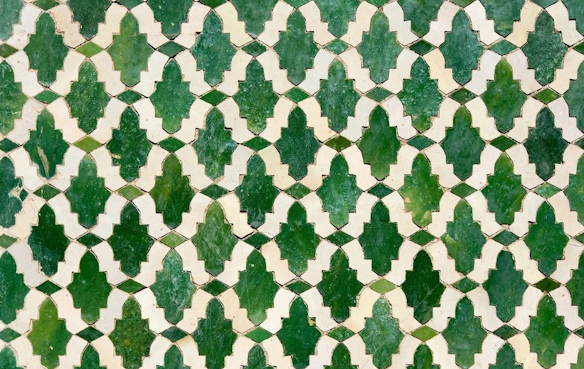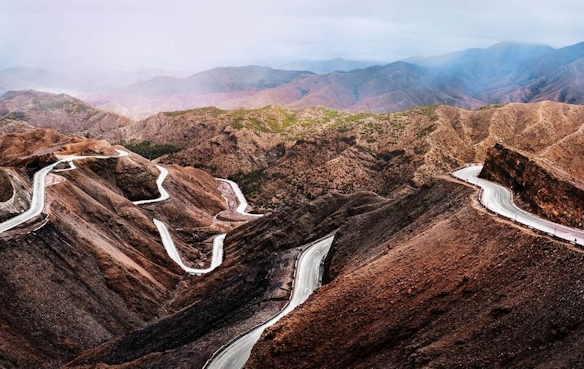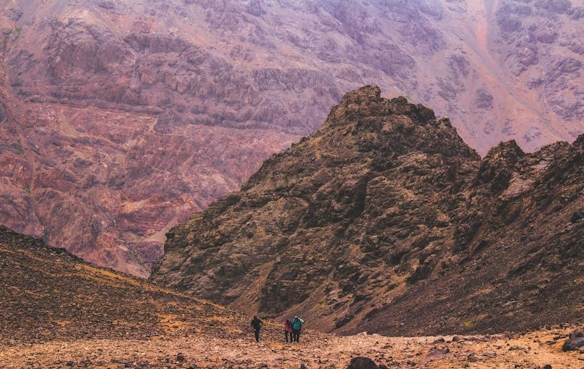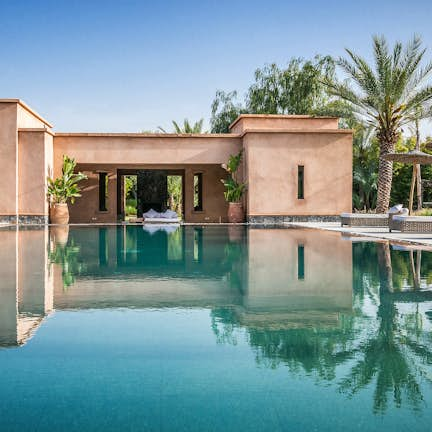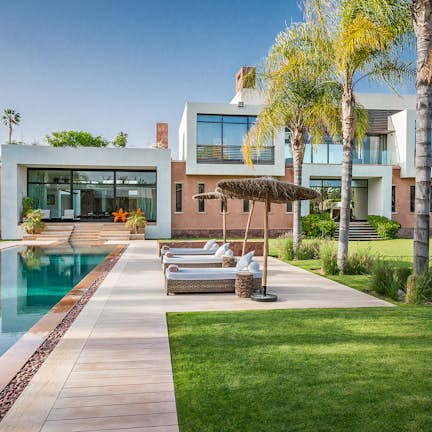Morocco is a beautifully diverse country in art, culture, and nature.
It’s home to diverse natural landscapes like the phenomenally craggy Atlas Mountains, a range that connects the country to Tunisia and Algeria, beaches and waterfalls. Parallel to its ancient landscapes, it is home to deeply rooted cultural artistic traditions.
One of those that stand out in Marrakech is the craft of zellige tiles. You’ve probably seen them in an interior design magazine or maybe your own kitchen.
If you’re staying in a Marrakech accommodation, you’ve likely seen the ceramic jigsaw puzzle of shapes on your floor or bathroom walls.
You know the ones. Small, perfectly imperfect polished clay tiles that line the walls or floors. Each one unique, because they’ve been made by hand. Intricate shapes cut into an explosion of colour and complex mathematical geometry.
These traditional Moroccan tiles are made with clay and water, hand-chiseled, dried and then baked.
These handmade squares that make interior designers swoon are a long-standing tradition in Marrakesh and Morocco overall. Similar to the Spanish and Portuguese tile practice of azulejo, they are a Moroccan decor that you can see, buy, make and indulge in during your next trip to Marrakech.
When you come to the Red City, pay attention. They’re everywhere. Even some of Marrakech’s streets are decorated with them. Spot them on the walls, floors pillars, tables, pools, and fountains.

In this article, we’re going to learn about their history, practice, and where you can see, buy and even make these Moroccan tiles on your next trip to Marrakech.
History of zellige tiles
These little polished tiles (their translation literally means “little polished stone”) come from a 10th-Century tradition and are one of the major characteristics of Marrakech.
Zellige tiles come from a primitive pottery tradition that dates all the way back to ancient Egypt. About 5000 years back, ancient craftsmen would shape colorful tiles out of the best clay they could find.
Much like us today, the Egyptians used the tiles to decorate the interior and exterior of their homes. They may not have had running water, but you can be sure the wealthy Egyptians had beautifully decorated bathrooms.
And just like many of today’s beautiful bathrooms, theirs were also decorated with colourful tiles. Maybe that’s why tiles in our homes today make us feel royal too. They remain a declaration of luxury and sophistication.
The ancient technique entailed drying clay bricks under the sun or baking them and then glazing them (the first were a stunning blue colour).
But it didn’t really get popular in the Middle East and Europe until the 10th Century when it spread across Andalusia and North Africa. That’s when the Moroccan tiles started their legacy as a staple of Marrrakech accommodations.
The technique remains nearly the same today.
How are zellige tiles made
Getting your zellige tiles from raw clay to your Marrakech riad’s floor is a process that is as complex as it is magnificent.
Today the Moroccan tiles are made in almost exactly the same way as they have been for the last seven centuries.
In this art, there’s nothing more important than the quality of the clay used. Each tile is made with unrefined natural clay, usually from the Fes region. They’re hand-shaped, dried and then kiln-fired.
Having a common background, the Andalusians shared this craft with the Moroccans in the 10th Century, and today they still use the same intricate geometrical shapes. But the Crusading Christians stopped the traditional art in Spain, where now the shapes are just printed and baked onto the tiles.
In Morocco, they take a small, 10-cm square of glazed clay tile and draw lines on them. Then they carefully break it into pieces along these lines with a small hammer.
They break the pieces into specific shapes: pointed stars or seals, cross, palm, almond, short neck, basket, and more, and then put them together like a bona fide jigsaw puzzle. The tiles are in geometric shapes because many sects of Islam forbid showing representations of living creatures in art.
Complex geometric shapes became the norm, interlacing and juxtaposed with one another.
So next time you see a tiled wall in your Marrakech private villa, take a moment to appreciate the deeply intricate and unique piece of art that it is.
A Marrakech tour of zellige tiles
If Marrakech is something apart from magnificently chaotic, it’s stylish and sophisticated.
This is a designer’s dream, a paradise for lovers of luxury.
If you fell in love with the ones you saw in your Marrakech accommodation and want to buy zellige tiles for your own home, read on to the next section. If you want to know where to admire the most beautiful Moroccan tiles in the Red City, this section is for you.
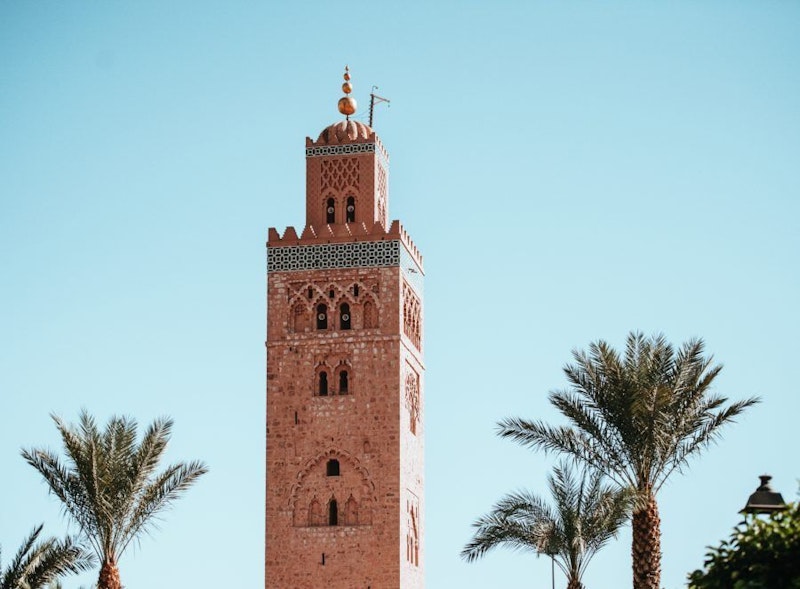
Koutoubia mosque in Marrakech
Though you probably have a lot to admire already in your Marrakech private villa, take a stroll into the medina to see the Koutoubia Mosque, the largest Mosque in Marrakech. It’s impossible to miss — you can see it from the riads in Marrakech or from almost any street in the medina.
If you’re Muslim, you’re allowed to enter the mosque and see the stunning 12th-Century earthenware tiles inside. However, non-Muslims are not allowed to enter the mosque. You can still see the Moroccan tile display on the minaret of the mosque from the outside.
Tourists are allowed to enter the Saadian Tombs, the burial ground of some royalty from the Saadian empire. There you can admire the lavish tilework open to the public.
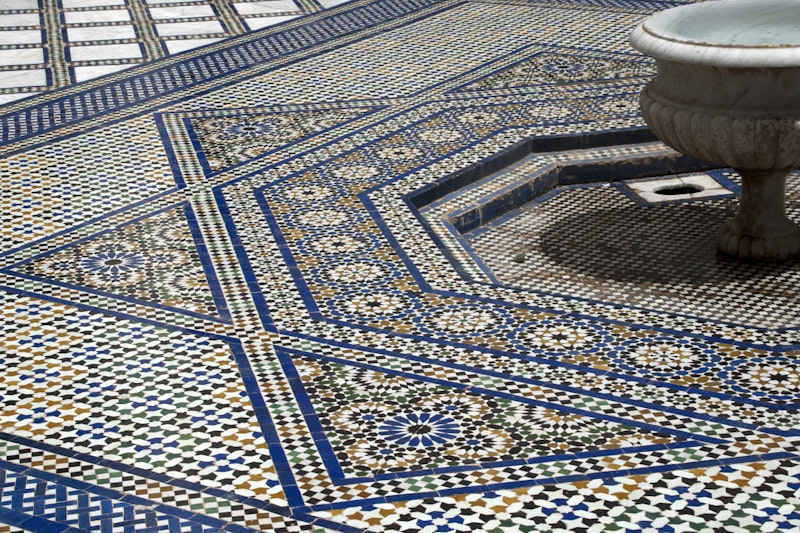
Zellige Tiles at Dar Si Said fountain in Marrakech
Dar Si Said, near the Bahia Palace, at the end of a narrow street, is a beautiful escape from the tourist crowds. Along with other kinds of Moroccan art, the tilework on the second floor of this building is simply sublime.
In any case, zellige tiles are something you’ll be able to see everywhere in the city — on fountains, interiors, exteriors, pillars and more. You can also take a 4-hour guided tour with the local tourist organization that will take you through the mosaics of the city.
Where to buy zellige tiles
If you fell in love with the bathroom in your Marrakech private villa and decided you absolutely need those tiles in your bathroom — you aren’t alone.
Luckily, Marrakech is the perfect place to buy these tiles. As you can probably imagine, they’re incredibly heavy and you’ll have to arrange for a way to ship them back home. This can be costly.
Before you decide to buy these Moroccan tiles for yourself, there are a few things to know:
Behind handmade, each tile is unique. The uneven edges can make them difficult to clean.
Because of their soft clay material, they can easily be damaged.
It’s expensive to ship.
If that’s okay with you, below are some great places to help you make your house look like the raids in Marrakech.
Some of the best, most local places to buy the zellige tiles will be something you find while exploring and getting lost in the souks of the medina.
One sure place you can get tiles is the following location:
Zellige Catrau – Complexe des potteries – Route d’Essaouira – KM 8 – N° 30
40000 Marrakech Medina, Morocco
This shop sells round and rectangular tables, flooring, bathrooms, fountains, wall tiles, and more and ships them back to you.
Where to make zellige
If you’ve got an artistic touch, you can immerse yourself deeper into the culture by learning to make the Moroccan tiles yourself.
Take home a piece of Morocco that you hand-shaped and glazed yourself just like the generations of master craftsmen are called maalems did before you arrived.
The Atelier d’Ailleurs, nestled between Guelez and Medina, smack dab in the middle of Marrakech, is a perfect place to plunge into Moroccan craftsmanship. At this centre, you can observe craftsmen at work shaping zellige tile pieces or weaving rugs.
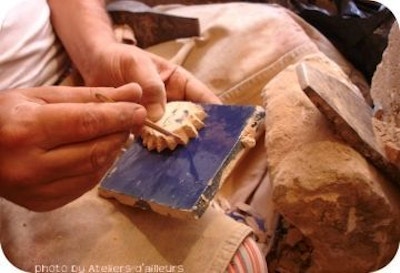
Zellige tile making at L'Atelier d'Ailleurs in Marrakech
Here you can take a 3-hour zellige workshop where you’ll learn to draw, cut and finish the zellige tiles from start to finish. You’ll never look at another Moroccan table the same after you see the work that goes behind it.
The workshop, guided by a zellige expert in an intimate, 5-person setting, costs a little over 100 euros (they can pick up from the Medina or Guelez for an additional charge).
At the Riad La Kahana Marrakech, one of the artsy riads of Marrakech, you can take a 5-hour mosaic zellige workshop. This Riad is a hotel near the Square Bab Mellah in the historic medina of Marrakech.
Together with the Zlayi, you’ll design, create and assemble your mosaic Moroccan tile creation. Next time you stay in a Marrakech private villa, you’ll have a deeper appreciation for every individual tile.
Making your stay in Marrakech an artistic one
When you stay at one of our Marrakech accommodations, you won’t be overwhelmed by the bustle, odours, and noises of the souks in the medina, but you will experience meticulous craftsmanship with a complexity that’s difficult to measure.
See, learn, and take home a piece of centuries of craftsmanship with you by enjoying the zellige tiles.
Wanting to get outside of the city and hike in the Atlas mountains? Check out our guide on how to visit in the Atlas mountains without feeling like a tourist.


